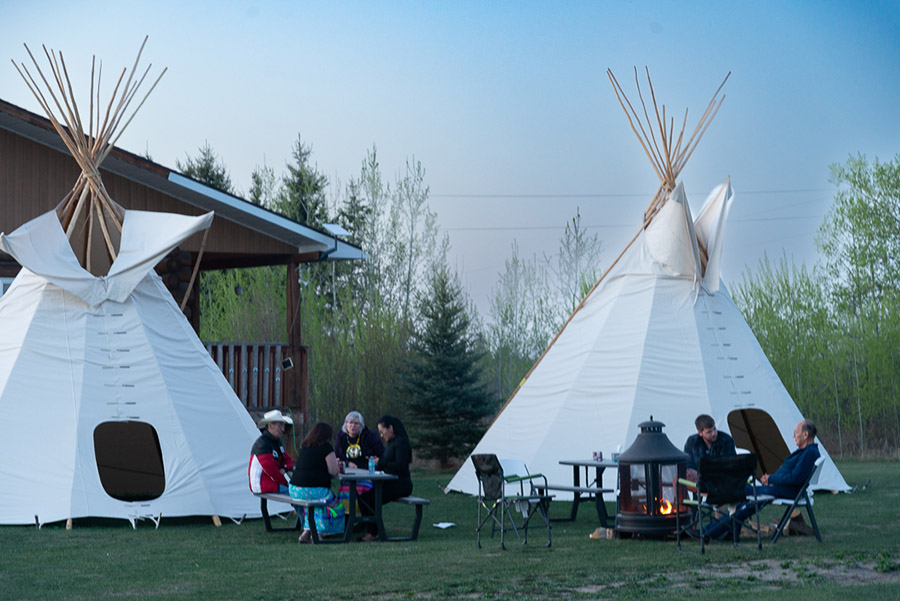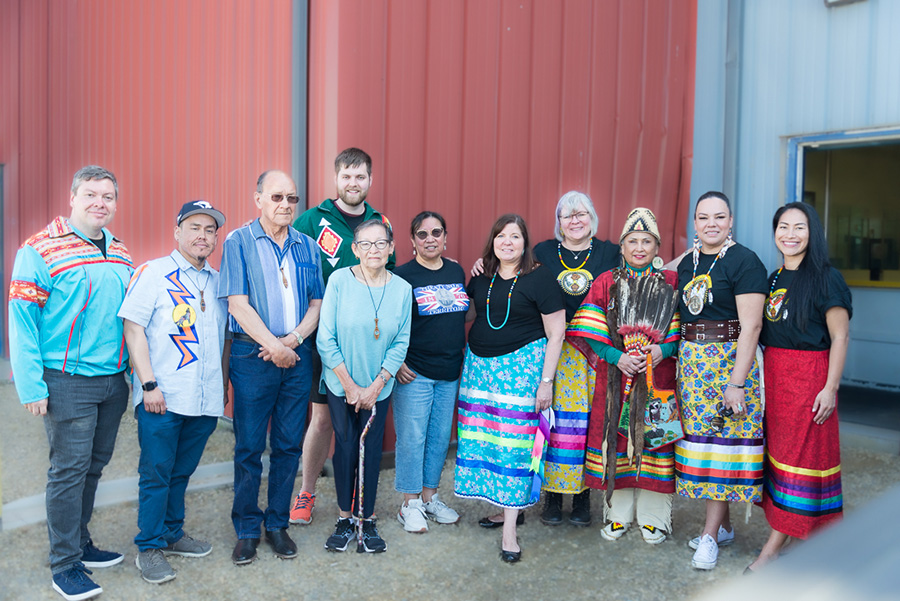Discovering gifts of learning in Indigenous communities: a journey towards UN Declaration implementation
There’s never a dull moment at Canadian Friends Service Committee! This year, for me, that’s meant lots of travel. Have you ever experienced the joys of travelling to a new place to learn from people you’ve just met? In anticipation, I’m often nervous and excited. Travel at CFSC provides amazing experiences and exciting opportunities to advance our work. This was absolutely the case at each research engagement I recently participated in as part of the Global Indigenous Rights Research Network project.
The Network connects the resources and experience of Indigenous and non-Indigenous academics, activists, and community organizations, including CFSC. The goal is to formalize our shared work to help bring tools and research on the UN Declaration on the Rights of Indigenous Peoples directly to Indigenous communities.
Professor Sheryl Lightfoot at the University of British Columbia received a Social Sciences and Humanities Research Council grant for our joint project Decolonizing Settler States. CFSC’s Jennifer Preston serves as the co-director with Sheryl. Through this project we seek to learn more about how Indigenous peoples are using the UN Declaration.
The three engagements I have participated in so far were in two Mohawk communities: Kahnawake and Kanehsatà:ke, and in Samson Cree Nation, Maskwacis territory.
I assumed (wrongly) that these research engagements would be straightforward: our team would make introductions and have conversations. Instead, on each trip, at the urging of community members, we were invited to step outside ourselves and to do some broader cultural learning. In Kahnawake we visited the Longhouse and heard how Clanmothers and Chiefs made decisions through consensus. In Kanehsatà:ke we walked the path of those who survived the 1990 Kanehsatà:ke siege. While in Samson Cree Nation, we were invited into the sacred pipe ceremony and participated in a mini pow wow. Let me tell you about them.
“We were invited to step outside ourselves and to do some broader cultural learning.”
The Longhouse in Kahnawake
Our conversation in Kahnawake focused on education. Education leaders are hard at work transforming the educational system to foster Mohawk ways of knowing. This informs their views on Declaration implementation. After our conversations, Kenneth Deer, our community lead, jumped in the van with us to show us around his community. The first stop on our tour was the Longhouse. Benches lined all sides of the open building. Kenneth showed us where each clan’s Chiefs sit and where the Clanmothers take their places.
As I imagined this taking place in the Longhouse, I saw how the design fostered consensus rather than antagonism. As Chiefs discuss the business of the day, procedures guide the way proposals are passed back and forth.
Meanwhile Clanmothers keep a close eye on things, appointing and dismissing Chiefs when necessary. Kenneth explained that oversight from the Clanmothers is essential for keeping conversations focused on peace and consistent with Mohawk laws. Every Chief knows the Clanmothers are watching as they discuss the decisions of the day.
As Kenneth shared these details, our research was enriched. Hearing about Kahnawake’s focus on consensus-building and maintaining Mohawk law gave context to our conversation about education rights and the right to self-determination. Understanding decision making in the Longhouse is crucial for understanding UN Declaration implementation in Kahnawake.
Walking the Path of the Kanehsatà:ke Siege
Our engagement in Kanehsatà:ke provided a different opportunity. Community members shared about the inspiring work they’re doing to serve the community through activism and advocacy. Many of the challenges they face stem from the lasting trauma inflicted on the community during the Kanehsatà:ke siege, often inaccurately referred to as the “Oka crisis.” Wanda Gabriel, a social worker from Kanehsatà:ke, taught about this trauma publicly in a video on our website. She explains that working through trauma requires an invitation to share stories without judgement. Her hope for the UN Declaration is that it helps Kanehsatà:ke reclaim their land and their place on it. Implementation of the UN Declaration in Kanehsatà:ke will require different levels of government to recognize and take responsibility for ongoing harms.
After our conversations, our tour of Kanehsatà:ke led us to the place where the 1990 siege occurred: a small road leading into the Pines, where a sacred Mohawk burial ground was being threatened by a golf course expansion. Our community lead, Katsi’tsakwas Ellen Gabriel, showed us where the Canadian military advanced on their territory and where violence occured. Seeing this place in person added immense weight to our conversations regarding the UN Declaration, especially in reference to the right to security for Indigenous peoples. It is one thing to hear how corporate and political interests can cause insecurity to Indigenous peoples. It’s quite another to walk the path of those that have faced it.
Sacred Pipe Ceremony and Mini Pow Wow in Samson Cree Nation
As in Kahnawake and Kanehsatà:ke, our time in Samson Cree Nation also provided opportunities for learning alongside our conversations. Our second day there began in teepees set up in our community lead—Laurie Buffalo’s—backyard.

Elders and community members gathered our team together for sacred pipe ceremonies. The pipe carriers prayed blessings, passed the pipe, and we each had an opportunity to take in the smoke. Afterwards an elder graciously shared the teachings of the ceremony. The stone at the end of the pipe that holds the tobacco is strong, so we should learn strength. The pipe stem is straight, calling us to truth and honesty. The tobacco smoke rose from the pipe as our prayers rise to teach us about Creator. Finally, the feather teaches us of sharing and of the ancestors that have gone before us. Being invited into this ceremony was a privilege and joy for everyone on the team.
That afternoon, we attended a mini pow wow meant to set our conversations on a good path. Dancers of all ages from little kids to Elders donned their regalia and danced. Just as it was beginning, I was quickly shuffled into the opening procession with Jennifer and other team members. Although my dancing skills left much to be desired, it was overwhelming to be honoured in this way and I was thankful for the guiding rhythm of the drum. Elders, chiefs, and an RCMP officer joined us in the procession. This officer was present as an affirmation of Treaty Six between Samson Cree Nation and Canada.
Both experiences informed the way our team processed our conversations. As community members shared about the need to interpret and implement the UN Declaration within a Cree context through Cree principles, we were lucky to have an insight into what those are. The teachings of the pipe and the celebration of the mini pow wow informed how the Declaration would be understood in a Cree context where principles of truth, honesty, community, and Treaty were of the utmost importance.
Conclusion
At each research engagement for this project, I was surprised by the unexpected places we were led. Engaging with work at the community level is critical for understanding and collaborating to implement the UN Declaration on the Rights of Indigenous Peoples. The Decolonizing Settler States project is also looking at Aotearoa New Zealand and Sampi (Nordic States). This winter Jennifer and Sheryl will be traveling to the Sami University in Norway. Watch for updates!
Jeremy Vander Hoek is Assistant, CFSC Events and Indigenous Rights.
